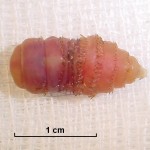-
Hurrah, most of the northern parts of the US have had a good frost. That is the end of the Bot fly cycle. Or is it?
Wikipedia describes Bot fly is the common name for a fly in the family Oestridae or maggots. It is one of several families of hairy flies whose larvae live as parasites within the bodies of mammals. There are approximately 150 known species world wide of hairy flies.
Texas A and M Extension tells us the fly is brownish , hairy and about 2/3 inches long. The life cycle is:
- Larvae develop in the digestive tract of the host animal in winter.
- In spring they pass to the host feces.
- Then the larvae are dropped with the feces and burrow into the ground.
- In 3-10 weeks the puparium emerge into adult flies. They look like honey bee.
- These bee looking bot flies are active mid-summer until fall.
- Adult females flies glue eggs to front legs, hind legs and bellies of the mammal.
- Eggs hatch in 10-140 days with proper stimulation of moisture, heat and friction.
- The horse bites or licks the egg infested hair of these areas.
- The larvae enter the mouth burrow into the tongue and lips for 28 days, molt and travel to the stomach for 9-10 months.
- The third stage (instar) develops in 5 weeks and then the cycle is complete. There is one generation a year and one female can lay 300 to 1000 eggs in the life.
Concerns:
We as horse owners must prevent the infestation that cause mechanical injuries and an infected ulcerous condition that progressively starves the host animal.
Remedies:
When the yellow eggs appear on the horses legs in the fall, remove with a sharp knife or Bot Stone™. After the first frost in late fall, use a paste deworming procedure containing ivermectin.
submitted by Karleen
Bot Flies, more than you want to know
Call Us at (910) 725-2115 or Email Us at info@horseflynet.com
Horse Fly Net
This see-through breathable screen will last for years. It is made of polyester vinyl coated and heat sealed on the edges with brass grommets about every foot. It has no chemicals added. Our HorseFlyNets only cost approximately $2.00 a square foot for smaller sizes and less for larger. Our product is woven and manufactured in the USA.
HorseFlyNet®
Southern Pines, NC
(910) 725-2115
info@horseflynet.com

